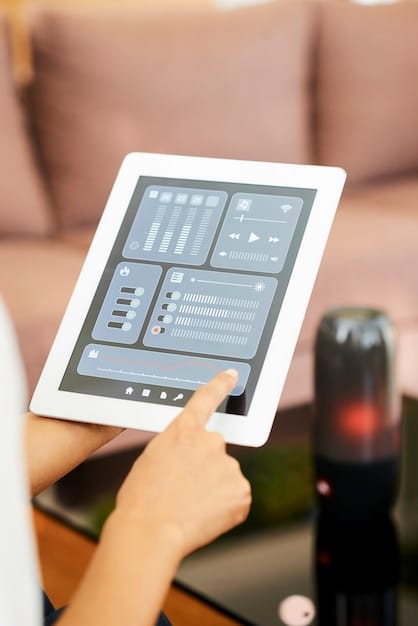5G’s Impact on Smart Homes: 40% Speed Boost & Reliability

5G technology is poised to revolutionize smart home performance, promising a substantial 40% increase in both speed and reliability, transforming the way devices connect and interact within a connected living space.
Imagine a smart home where every device responds instantly, without lag or interruption. The impact of 5G on smart home performance: expect a 40% increase in speed and reliability, making this vision a tangible reality.
Unleashing the Power of 5G in Smart Homes
The advent of 5G technology is set to redefine the capabilities of smart homes. This isn’t just about faster internet; it’s about creating a more responsive, reliable, and interconnected ecosystem within your living space.
5G’s potential impact on the smart home landscape is significant, offering a glimpse into a future where devices communicate seamlessly and intelligently. Let’s explore how this technological shift will impact various aspects of smart home functionality.
Enhanced Bandwidth and Reduced Latency
One of the primary benefits of 5G is its ability to provide significantly increased bandwidth and reduced latency compared to previous generations of wireless technology. What does this mean for your smart home?
Essentially, it means that your devices can transmit and receive data much faster, leading to quicker response times and smoother operation. This is particularly crucial for applications that require real-time data processing, such as video streaming and interactive gaming.
- Faster Downloads and Uploads: Enjoy seamless streaming and quicker software updates for all your smart devices.
- Improved Real-Time Performance: Experience lag-free video conferencing, gaming, and remote control of your home appliances.
- Enhanced IoT Connectivity: Connect more devices without compromising network performance.
With 5G, smart homes can handle a much larger number of connected devices without experiencing performance degradation. This is essential as the number of smart devices in homes continues to grow.

Boosting Reliability and Stability
Beyond speed, 5G also brings a new level of reliability and stability to smart home networks. Traditional Wi-Fi networks can be prone to congestion and interference, especially in densely populated areas.
5G networks are designed to be more resilient and less susceptible to these issues, ensuring a consistent and dependable connection for all your smart devices. This enhanced reliability translates to a more seamless and predictable smart home experience.
Overcoming Wi-Fi Limitations
While Wi-Fi has served as the primary connectivity solution for smart homes, it has its limitations. Congestion, interference, and range constraints can all impact performance. 5G offers an alternative that addresses these challenges.
By providing a dedicated and reliable connection, 5G can minimize disruptions and ensure that your smart devices function as intended. This is particularly important for critical applications like security systems and healthcare devices.
Consistent Connectivity for Remote Monitoring
5G offers consistent connectivity, which is essential for remote monitoring of your home. Whether you’re checking in on your security cameras or adjusting your thermostat from afar, you can rely on a stable and dependable connection.
- Enhanced Security: Receive instant alerts from your security system, even in areas with weak Wi-Fi signals.
- Improved Convenience: Control your home appliances from anywhere with a reliable connection.
- Greater Peace of Mind: Stay connected to your home and loved ones, regardless of your location.
The enhanced reliability of 5G can provide greater peace of mind, knowing that your smart devices are always connected and functioning properly. This is especially important for those who travel frequently or live in areas with unreliable internet service.
In conclusion, 5G significantly enhances the reliability and stability of smart home networks, ensuring a consistent and dependable connection for all your devices.
Impact on Smart Home Applications
The faster speeds and increased bandwidth of 5G unlock a new realm of possibilities for smart home applications. From enhanced entertainment experiences to improved security systems, 5G is set to revolutionize the way we interact with our homes.
Here’s a glimpse into how 5G will impact some key smart home applications:
Entertainment and Streaming
For entertainment enthusiasts, 5G offers a significant upgrade to the streaming experience. Enjoy ultra-high-definition (UHD) video streaming without buffering or lag, even on multiple devices simultaneously. 5G also enables new immersive entertainment experiences, such as augmented reality (AR) and virtual reality (VR) applications.
5G can transform the way we consume entertainment in our homes, offering a more seamless and immersive experience. Whether you’re watching movies, playing games, or exploring virtual worlds, 5G provides the bandwidth and low latency needed for optimal performance.
Security and Surveillance
5G enhances the capabilities of smart home security systems, enabling features such as real-time video surveillance, facial recognition, and remote control of door locks. 5G’s low latency ensures that alerts are delivered instantly, allowing for quicker response times in emergency situations.
- Faster Video Transmission: View high-resolution security footage in real-time without delays.
- Enhanced Facial Recognition: Improve the accuracy and speed of facial recognition systems for enhanced security.
- Remote Control of Door Locks: Lock and unlock your doors remotely with confidence.
With 5G, smart home security systems become more responsive and reliable, offering greater protection and peace of mind. The ability to monitor your home in real-time and respond quickly to potential threats is a significant advantage.
Overall, 5G’s impact on smart home applications is broad and transformative, enhancing entertainment, security, and automation capabilities.

The Role of 5G in Energy Management
Smart homes are becoming increasingly focused on energy efficiency, and 5G is poised to play a key role in improving energy management capabilities. By enabling smarter and more responsive energy management systems, 5G can help homeowners reduce their energy consumption and save money.
Here’s how 5G contributes to energy management in smart homes:
Smart Thermostats and HVAC Systems
5G can enhance the performance of smart thermostats and HVAC systems, allowing for more precise temperature control and energy optimization. By analyzing real-time data from sensors and weather forecasts, these systems can adjust settings automatically to minimize energy consumption while maintaining comfort.
5G-enabled smart thermostats can learn your preferences and adjust settings accordingly, ensuring optimal comfort and energy savings. They can also be controlled remotely, allowing you to adjust the temperature from anywhere.
Smart Lighting and Appliance Control
5G enables more sophisticated control of smart lighting and appliances, allowing homeowners to optimize their energy usage. Smart lighting systems can adjust brightness based on ambient light levels and occupancy, while smart appliances can be programmed to operate during off-peak hours.
- Automated Lighting Control: Reduce energy waste by automatically adjusting lighting levels based on occupancy and ambient light.
- Appliance Scheduling: Schedule appliances to operate during off-peak hours to save money on electricity bills.
- Remote Energy Monitoring: Track your energy consumption in real-time and identify areas for improvement.
5G’s high-speed connectivity enables seamless communication between these devices, allowing for more efficient energy management. With 5G, homeowners can take greater control of their energy consumption and reduce their carbon footprint.
In summary, 5G plays a crucial role in enhancing energy management in smart homes, enabling smarter and more responsive systems.
Overcoming Challenges and Embracing the Future
While the potential benefits of 5G in smart homes are compelling, there are also challenges to consider. Overcoming these challenges will be essential for widespread adoption and realizing the full potential of 5G-enabled smart homes.
Let’s examine some of the key challenges and how they can be addressed:
Infrastructure Development
One of the biggest challenges is the infrastructure development required to support 5G networks. Building out the necessary infrastructure, including cell towers and fiber optic cables, is a complex and costly undertaking. Collaboration between telecommunications companies, government agencies, and communities will be essential for accelerating the deployment of 5G networks.
Without widespread 5G coverage, the benefits of 5G-enabled smart homes will be limited. Investing in infrastructure development is crucial for making 5G accessible to everyone.
Security Concerns
As with any new technology, security is a major concern. 5G networks are complex and can be vulnerable to cyberattacks. Protecting 5G networks from security threats is essential for maintaining the integrity and reliability of smart home devices.
- Robust Security Protocols: Implement strong security protocols to protect 5G networks from cyberattacks.
- Regular Security Audits: Conduct regular security audits to identify and address potential vulnerabilities.
- User Education: Educate users about best practices for securing their smart home devices.
Addressing these security concerns will be critical for building trust and ensuring the widespread adoption of 5G-enabled smart homes. Security must be a top priority.
In conclusion, overcoming challenges related to infrastructure development and security will be key to embracing the future of 5G in smart homes.
Future Trends in 5G Smart Homes
The future of 5G smart homes is filled with exciting possibilities. As technology continues to evolve, we can expect to see even more innovative applications and features that enhance our living spaces.
Here are some key trends to watch out for:
Artificial Intelligence (AI) Integration
AI will play an increasing role in 5G smart homes, enabling more intelligent and automated systems. AI-powered virtual assistants will become even more sophisticated, learning our preferences and anticipating our needs. AI will also be used to optimize energy consumption, improve security, and enhance entertainment experiences.
The integration of AI will transform smart homes from being simply connected to being truly intelligent, adapting to our lifestyles and making our lives easier.
Enhanced Interoperability
As the number of smart devices in homes continues to grow, interoperability will become increasingly important. Consumers will want devices from different manufacturers to work seamlessly together.
- Standardized Protocols: Adopt standardized protocols to enable seamless communication between devices.
- Open Platforms: Encourage the development of open platforms that allow developers to create interoperable applications.
Enhanced interoperability will create a more cohesive and user-friendly smart home experience. Consumers will be able to choose the best devices for their needs, regardless of the manufacturer, and easily integrate them into their smart home ecosystem.
In summary, the future of 5G smart homes is bright, with trends pointing towards greater AI integration and interoperability.
| Key Point | Brief Description |
|---|---|
| 🚀 Speed Increase | Expect a 40% increase in connection speed with 5G. |
| 📶 Reliability Boost | Experience a more stable and consistent connection for all devices. |
| 💡 Energy Efficiency | 5G enables smarter energy management and reduced consumption. |
| 🔒 Enhanced Security | Improved real-time video surveillance and faster alerts. |
Frequently Asked Questions
▼
5G enhances smart home performance by providing faster speeds, lower latency, and more reliable connections. This results in quicker response times and smoother operation of smart devices.
▼
5G is expected to deliver a 40% increase in both the speed and reliability of smart home devices. This improvement enhances the overall user experience.
▼
Yes, 5G is designed to handle a large number of connected devices without sacrificing performance. This ensures that the user experience remains seamless.
▼
Like any new technology, security is a major concern. Robust security protocols and regular audits are essential to protect 5G networks from cyberattacks.
▼
5G allows for precise temperature control, automated lighting, and optimized appliance usage. It enables smart homes to reduce energy consumption.
Conclusion
In conclusion, 5G technology promises to significantly enhance smart home performance. The expected 40% increase in speed and reliability, along with improved energy management and security, will revolutionize how we interact with our living spaces, making them more responsive and user-friendly. Embracing the future of 5G in smart homes will unlock a new world of possibilities.





